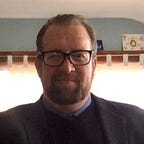Something Closer to the Truth
Last night, I went up to the attic and explored that corner where Laura and I keep some folders in dusty document boxes. They hold the artifacts of our earlier lives, and they’re buried behind the Christmas decorations, luggage, piles of the kids’ old clothes, and loads of books.
I was looking for two things; my medical records from the night I was admitted, and a “personal essay” about the night and days I spent in the hospital following my diagnosis. The records could tell me exactly, at least in a physiological sense, what happened the night I was diagnosed. The essay, which I wrote for a literary non-fiction class I took at University of Iowa, was a way to verify my memory 26 years after the fact.
I couldn’t find the records anywhere. I even checked that box in the basement where we keep the tax returns (“Hon, why do we still have bank records from when we lived in Atlanta??”). I did find one cool thing. It was a July 1995 letter from the cardiologist who treated me in Iowa, Dr. James Martins, to Dr. Greg Sullivan, an old family friend, who would treat me when I went back east. I probably could order the records from the hospital. Without them, the letter is the only artifact I have from the time I was in the hospital in Iowa. Which is OK, because it is a perfect summary of my treatment that night and in the days that followed.
I was a 25 year old grad student at the University of Iowa Journalism School in July of 1995, when I was first diagnosed with my disease (let’s call it ARVD). I was treated, thankfully, at the University of Iowa Hospital, where the best cardiologists in the state deal with the most significant cases in the region. There, a cardiologist named James Martins took over my treatment from what I recall was a frightened and overwhelmed resident.
From the summary letter to Dr. Sullivan, I can divine certain facts. For example, when I presented to the ER, I was “cooperative and in no acute distress.” This is a strong deviation from my memory, I remember being kind of freaked out and panicked. I asked my wife, “when you guys took me to the hospital that night, would you say I was in acute distress?”
“Yes, absolutely,” was her immediate answer. She thought for a beat and said, “no, actually. You were sort of calm and you did that thing you do where you squeeze your hands and do the exaggerated breathing.” We’ve been living with ARVD long enough for Laura to say I “do a thing” when I’m having a episode of tachycardia (let’s call it VTach). “And you were kind of jokey, like you were trying to downplay it, even though you knew it was serious.” This is a recurrent theme of my life with this illness.
When I was admitted, my heart rate was 219 beats per minute. As an athletic 25 year old in good health, my heart rate at peak exercise should not have exceeded around 200 bpm and not for very long. By the time we got to the hospital, my heart had been beating at that rate for hours.
They first tried a combination of “carotid sinus massage and IV adenosine without improvement.” Then, “a lidocaine drip was started without success.” The letter notes that “the patient [that’s me!] was then sedated and successfully cardioverted to normal sinus rhythm with 50 joules!” [CLEAR!!] and “admitted to the CVICU for futher evaluation.”
The letter from Dr. Martins to Dr. Sullivan, while interesting to read, just confirmed what I already knew; that in July 1995 I’d had a severe episode of cardiac arrhythmia, precipitated by an underlying heart defect. In the week that followed, I underwent various tests to determine what had caused my VTach. Ultimately, a CT scan “confimed the diagnosis of right ventricular dysplasia, revealing only a small amount of functioning myocardium along the anterior wall of the right ventricle near the apes, with a markedly dialated and severely hypokinetic right ventricle , and possible thickening of the anterior leaflet of the mitral valve.” In English, that means my heart is fucked. Only a tiny bit of the muscular tissue of the heart in the right ventricle, which is grossly misshapen, works at all, and the part that does work can barely push my blood around my body.
“Mr. Heyman,” notes Dr. Martins in the dry language of a physician, “was instructed not to engage in strenuous exercise or competitive sports.” This was a warning that would go largely unheeded for years, a few times with near catastrophic results. In addition to being bad at timing, I’m not the best at self-control.
— — — — — — —
I was frankly afraid to find the essay. I’m pretty sure everything I wrote when I was 25 was crap. More searching led me back to the attic to check one more box, and the essay was the first document I pulled out of the first folder I opened. It does not disappoint in the crap department. However, it offers details of the night I was diagnosed that I’ve long since forgotten, including a conversation I had with my dad when I first awakened. More on that next time …
